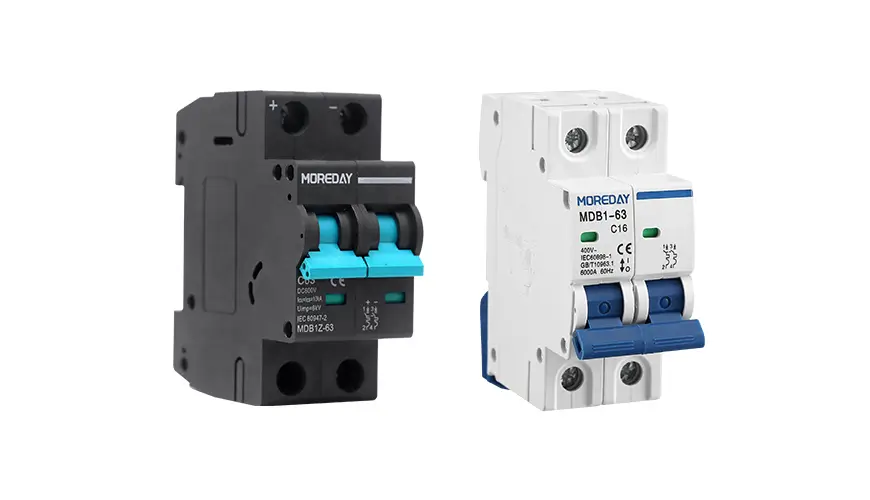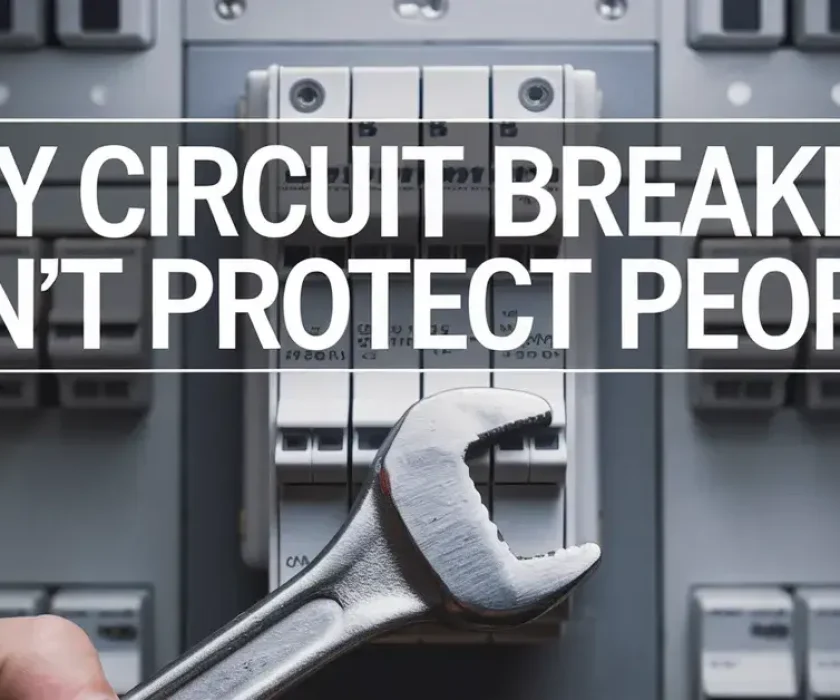M
iniature Circuit Breakers (MCBs) are essential components in electrical systems, providing protection against overloads and short circuits. They come in different types, each designed for specific applications and characteristics. This article will explore the differences between Type A, B, C, and D MCBs, helping you understand their unique features and appropriate uses.
Overview of Miniature Circuit Breakers (MCBs)
MCBs are automatic electrical switches designed to protect electrical circuits from damage caused by excess current from overloads or short circuits. They interrupt current flow when a fault is detected, protecting the circuit and connected devices. MCBs are classified into different types based on their tripping characteristics, which determine how quickly they respond to various levels of overcurrent.
Type A MCBs
Type A Miniature Circuit Breakers are specifically designed to offer enhanced protection for sensitive loads and equipment. They are a relatively newer addition to the MCB family, developed to address the growing need for protection against more complex current waveforms in modern electrical systems.
Key features and characteristics:
Sensitivity: Type A MCBs are highly sensitive to small current fluctuations, making them ideal for protecting delicate electronic equipment.
Residual Current Detection: They can detect and respond to both residual alternating currents (AC) and pulsating direct currents (DC). This makes them suitable for circuits that may experience both types of fault currents.
Response Time: Type A MCBs have a very quick response time, typically faster than other MCB types, to minimize potential damage to sensitive equipment.
Tripping Mechanism: They use a combination of thermal and electronic tripping mechanisms to provide accurate and reliable protection.
Voltage Rating: Typically available for both single-phase and three-phase systems, with common voltage ratings of 230V and 400V.
Current Ratings: Usually available in lower current ratings, often ranging from 6A to 40A, to suit the needs of sensitive equipment.
Applications:
Electronic Laboratory Equipment: Protecting sensitive measurement and testing devices.
Medical Equipment: Safeguarding diagnostic and patient monitoring systems in healthcare facilities.
Home Office Equipment: Protecting computers, printers, and other IT equipment.
Audio-Visual Systems: Ensuring the safety of high-end sound systems and video equipment.
Smart Home Devices: Protecting IoT devices and home automation systems.
Telecommunication Equipment: Safeguarding servers, routers, and other network infrastructure.
Advantages:
- Enhanced Protection: Offers superior protection against a wider range of fault currents compared to standard MCBs.
- Reduced Nuisance Tripping: Designed to differentiate between harmless current fluctuations and genuine faults, minimizing unnecessary interruptions.
- Compliance: Meets stringent safety standards for protecting sensitive electronic equipment.
Considerations:
- Cost: Type A MCBs are generally more expensive than standard MCB types due to their advanced features.
- Selectivity: When using Type A MCBs, it’s important to ensure proper coordination with other protective devices in the electrical system.
- Installation: While similar to other MCB types, installation should be carried out by qualified professionals familiar with the specific requirements of Type A MCBs.
Type B MCBs
Type B Miniature Circuit Breakers are widely used in residential and light commercial applications. They are designed to provide a balance between sensitivity and tolerance to normal load variations.
Key features and characteristics:
Tripping Characteristics: Type B MCBs are designed to trip when the current reaches 3 to 5 times the rated current. This allows for a slight overload without unnecessary tripping.
Response Time: They have a moderately fast response time, suitable for protecting most household and light commercial circuits.
Magnetic Trip: The instantaneous tripping occurs at about 3-5 times the rated current, providing protection against short circuits.
Thermal Trip: For overload protection, they use a bimetallic strip that bends when heated by excess current, triggering the breaker.
Voltage Rating: Typically available for 230V single-phase and 400V three-phase systems.
Current Ratings: Usually available in a range from 6A to 63A, covering most residential and light commercial needs.
Applications:
General Household Circuits: Protecting lighting circuits, socket outlets, and general-purpose appliances.
Residential Appliances: Suitable for refrigerators, washing machines, and other common household devices.
Light Commercial Use: Protecting office equipment, small retail shop circuits, and similar light commercial applications.
Resistive Loads: Ideal for heaters, electric stoves, and other resistive loads with minimal inrush current.
Lighting Systems: Well-suited for incandescent, LED, and other lighting systems without high inrush currents.
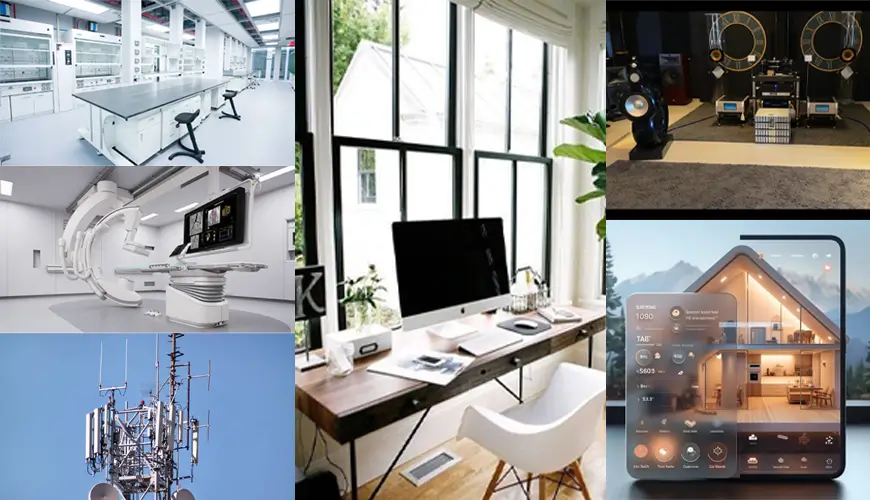
Advantages:
- Versatility: Suitable for a wide range of common household and light commercial applications.
- Cost-Effective: Generally less expensive than Type C or D MCBs, making them economical for residential use.
- Standard Protection: Provides reliable protection against both overloads and short circuits in typical residential scenarios.
Considerations:
- Inrush Current Limitations: May not be suitable for loads with high inrush currents, as they might cause nuisance tripping.
- Not for Sensitive Equipment: While adequate for general use, they may not provide the level of protection needed for sensitive electronic equipment.
- Industrial Limitations: Not typically suitable for industrial applications or heavy machinery.
Type C MCBs
Type C Miniature Circuit Breakers are designed for commercial and industrial applications, particularly suited for loads with higher inrush currents. They offer a balance between the sensitivity of Type B and the high tolerance of Type D MCBs.
Key features and characteristics:
Tripping Characteristics: Type C MCBs are designed to trip when the current reaches 5 to 10 times the rated current. This higher threshold allows for larger inrush currents without nuisance tripping.
Response Time: They have a slower response time compared to Type B MCBs, allowing for brief current surges during equipment startup.
Magnetic Trip: The instantaneous tripping occurs at about 5-10 times the rated current, providing protection against short circuits while tolerating higher momentary currents.
Thermal Trip: Like other MCB types, they use a bimetallic strip for overload protection, but it’s calibrated for higher tolerances.
Voltage Rating: Typically available for 230V single-phase and 400V three-phase systems, with some models available for higher voltages in industrial applications.
Current Ratings: Usually available in a range from 0.5A to 125A, covering a wide spectrum of commercial and industrial needs.
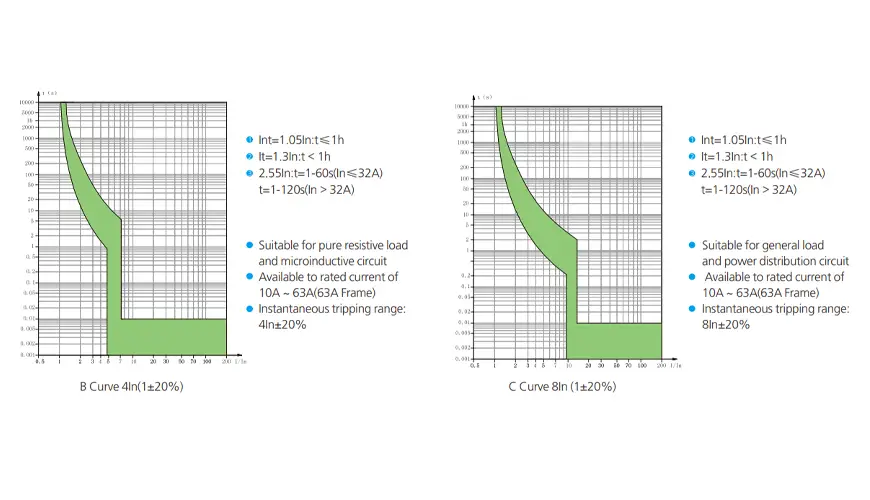
Applications:
Motors and Pumps: Ideal for protecting circuits with small to medium-sized motors that have significant startup currents.
Transformers: Suitable for protecting transformer circuits, which often experience inrush currents during energization.
Fluorescent Lighting: Well-suited for large fluorescent lighting installations, which can have high inrush currents when switched on.
Power Tools: Appropriate for workshops and construction sites where power tools with motors are frequently used.
HVAC Systems: Suitable for air conditioning and heating systems with compressors and fans.
Commercial Refrigeration: Ideal for protecting compressors in commercial refrigeration units.
Industrial Control Panels: Often used in control circuits for industrial machinery and equipment.
Advantages:
- Versatility: Suitable for a wide range of commercial and light industrial applications.
- Inrush Current Tolerance: Can handle higher inrush currents without nuisance tripping, improving system reliability.
- Balanced Protection: Offers a good balance between overload protection and tolerance for temporary current spikes.
- Energy Efficiency: By allowing for normal inrush currents, they can contribute to overall system efficiency by reducing unnecessary downtime.
Considerations:
- Not for Sensitive Loads: May not provide adequate protection for very sensitive electronic equipment.
- Coordination: Careful coordination with other protective devices is necessary to ensure proper selectivity in the electrical system.
- Cost: Generally more expensive than Type B MCBs due to their more specialized characteristics.
Type D MCBs
Type D Miniature Circuit Breakers are designed for heavy industrial applications and loads with very high inrush currents. They offer the highest tolerance for current surges among standard MCB types.
Key features and characteristics:
Tripping Characteristics: Type D MCBs are designed to trip when the current reaches 10 to 20 times the rated current. This high threshold allows for very large inrush currents without nuisance tripping.
Response Time: They have the slowest response time among standard MCB types, allowing for significant current surges during equipment startup or operation.
Magnetic Trip: The instantaneous tripping occurs at about 10-20 times the rated current, providing protection against severe short circuits while tolerating high momentary currents.
Thermal Trip: The bimetallic strip for overload protection is calibrated for the highest tolerances among standard MCB types.
Voltage Rating: Typically available for 230V single-phase and 400V three-phase systems, with models available for higher voltages in specialized industrial applications.
Current Ratings: Usually available in a range from 0.5A to 125A, covering a wide spectrum of heavy industrial needs.
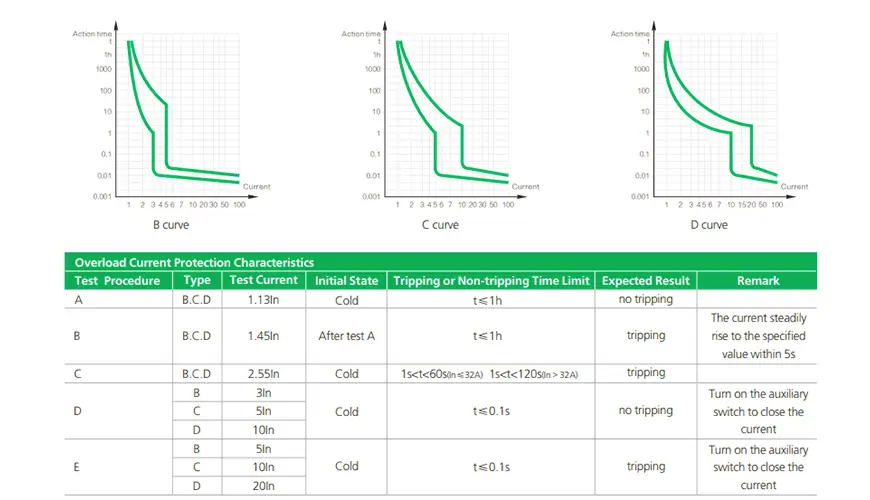
Applications:
Large Motors: Ideal for protecting circuits with large motors that have significant startup currents, such as those used in heavy machinery or industrial pumps.
Welding Equipment: Well-suited for welding machines, which can draw very high currents during operation.
X-ray Machines: Appropriate for medical and industrial X-ray equipment, which requires high power for brief periods.
Industrial Transformers: Suitable for large transformers with substantial inrush currents during energization.
Heavy-Duty Power Tools: Used in industrial settings where powerful tools with high startup currents are common.
Elevators and Lifts: Provides protection for elevator motors and associated equipment.
Industrial Compressors: Ideal for large air compressors and refrigeration systems in industrial settings.
Advantages:
- High Inrush Current Tolerance: Can handle very high inrush currents without tripping, essential for equipment with large startup demands.
- Reduced Downtime: By avoiding unnecessary trips due to normal startup surges, Type D MCBs help maintain operational continuity in industrial settings.
- Versatility in Heavy Industry: Suitable for a wide range of heavy industrial applications where other MCB types would be inadequate.
- Long-Term Reliability: Designed to withstand repeated high-current events without degradation of performance.
Considerations:
- Not for Sensitive Equipment: Due to their high trip thresholds, Type D MCBs are not suitable for protecting sensitive electronic equipment or standard residential circuits.
- Coordination: Careful coordination with other protective devices is crucial to ensure proper selectivity and overall system protection.
- Cost: Generally the most expensive among standard MCB types due to their specialized characteristics and robust construction.
- Physical Size: May be larger than other MCB types to accommodate the higher current-carrying capacity.
Comparison Table
| Feature | Type A | Type B | Type C | Type D |
|---|---|---|---|---|
| Tripping Range | Highly sensitive (specific range varies) | 3-5x rated current | 5-10x rated current | 10-20x rated current |
| Typical Applications | Electronic equipment, sensitive instruments | Residential circuits, lighting, socket outlets | Motors, transformers, fluorescent lighting | Large motors, welding equipment, X-ray machines |
| Sensitivity to Current Fluctuations | Very High | Moderate | Low | Very Low |
| Response to Inrush Currents | May trip | May trip on high inrush | Tolerates moderate inrush | Tolerates high inrush |
| Suitability for Electronic Loads | Excellent | Good | Limited | Not recommended |
| Use in Residential Settings | Limited (specific applications) | Widely used | Limited use | Rarely used |
| Use in Commercial Settings | Specific applications | Light commercial use | Widely used | Limited use |
| Use in Industrial Settings | Specific applications | Rarely used | Common | Widely used |
| Protection Against Residual Currents | Yes (AC and pulsating DC) | No | No | No |
| Typical Current Ratings | 6A – 40A | 6A – 63A | 0.5A – 125A | 0.5A – 125A |
| Relative Cost | High | Low | Moderate | High |
| Speed of Response | Very Fast | Fast | Moderate | Slow |
| Nuisance Tripping Likelihood | High (for non-electronic loads) | Moderate | Low | Very Low |
| Suitability for Motor Circuits | Poor | Poor | Good | Excellent |
| Magnetic Trip Point | Very low | Low | Moderate | High |
| Thermal Trip Mechanism | Present | Present | Present | Present |
| Typical Voltage Ratings | 230V/400V | 230V/400V | 230V/400V | 230V/400V (higher available) |
| Selectivity with Other Devices | Requires careful coordination | Standard coordination | Good coordination | Excellent coordination |
| Use with Transformers | Not recommended | Not recommended | Suitable | Highly suitable |
| Suitability for Lighting Circuits | Depends on type | Excellent for standard | Good for fluorescent | Rarely used |
| Compliance with IEC 60898 | Yes | Yes | Yes | Yes |
Conclusion
Understanding the differences between Type A, B, C, and D Miniature Circuit Breakers is crucial for ensuring proper electrical protection in various settings. Each type is designed to handle specific load characteristics and inrush currents, making them suitable for different applications ranging from sensitive electronic equipment to heavy industrial machinery.
The selection of the appropriate MCB type is a critical decision that impacts the safety, reliability, and efficiency of electrical systems. By understanding the unique characteristics and applications of Type A, B, C, and D MCBs, electrical professionals can design systems that provide optimal protection for a wide range of scenarios, from sensitive home electronics to heavy industrial machinery.
As electrical technologies continue to evolve, so too will the demands placed on circuit protection devices. Therefore, it’s important to approach MCB selection not as a one-time decision, but as an ongoing process of evaluation and adaptation to changing needs and technologies. By doing so, we can ensure that our electrical systems remain safe, efficient, and reliable in the face of ever-changing demands and innovations.
FAQ`s.
Q1: What is the main difference between Type A, B, C, and D MCBs?
A1: The main difference lies in their tripping characteristics. Type A is highly sensitive, Type B trips at 3-5 times rated current, Type C at 5-10 times, and Type D at 10-20 times rated current.
Q2: Can I use a Type B MCB for all household applications?
A2: While Type B MCBs are suitable for most household applications, certain devices with higher inrush currents might require Type C MCBs.
Q3: Why would I need a Type A MCB?
A3: Type A MCBs are used for circuits with sensitive electronic equipment or where protection against both AC and pulsating DC residual currents is required.
Q4: Can I replace a Type B MCB with a Type C MCB?
A4: While physically possible, it's not recommended without a proper assessment. Type C MCBs have different tripping characteristics and may not provide adequate protection for typical residential circuits.
Q5: How do I know which MCB type to use for a specific application?
A5: Consider the load characteristics, inrush current, and operating environment. Consult with a qualified electrician or refer to manufacturer guidelines for specific applications.
Derek Ke
Hi, I’m Derek Ke, founder of Moreday.com, an expert in solar-protected electrical products and electric vehicle charging.
Over the past 15 years, we have helped nearly 500 customers (such as farms, residential, industrial, and commercial) in 60 countries solve new energy and green power problems. We aim to share more knowledge about solar power generation and new energy with everyone so that green electricity can enter thousands of households.






